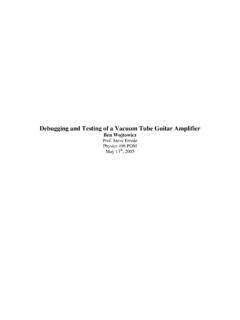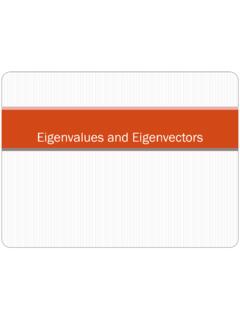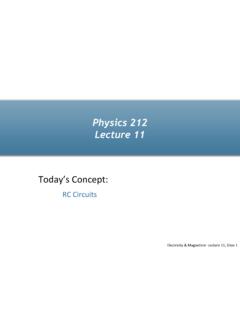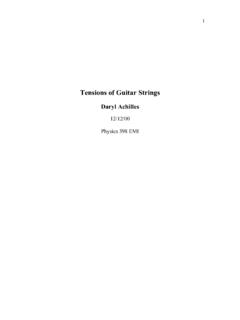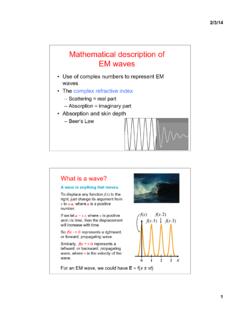Transcription of Quantum Tunneling
1 Quantum TunnelingIn this chapter, we discuss the phenomena which allows an electron to quan-tum tunnel over a classically forbidden eV9 eV99% of timeRolls over10 eV1% of the time10 eVRolls backThis is a strikingly non-intuitive process where small changes in either theheight or width of a barrier create large changes the Tunneling current of particlescrossing the barrier. Quantum Tunneling controls natural phenomena such asradioactive decay where a factor of three increase in the energy released duringa decay is responsible for a 1020fold increase in the decay rate.
2 The inherentsensitivity of the Tunneling process can be exploited to produce photographsof individual atoms using scanning Tunneling microscopes (STM) or produceextremely rapid amplifiers using Tunneling diodes. It is an area of physics whichis as philosophically fascinating as it is technologically of this chapter deals withcontinuumrather than bound state bound state problems, one is usually concerned with solving for possible sta-tionary state energies. In Tunneling problems, one has a continuous spectrumof possible incident energies.
3 In these problems we are generally concerned withsolving for the probability that an electron is transmitted or reflected from agiven barrier in terms of its known incident CurrentTunneling is described by a transmission coefficient which gives the ratioof the current density emerging from a barrier divided by the current densityincident on a barrier. Classically the current density~Jis related to the charge1density and the velocity charge velocity~vaccording to~J= ~v. Its natural torelate the current density with the electron chargeeand the Quantum PDF(x)according to =e (x) (x).
4 It is equally natural to describe the velocityby p/mwhere (in 3 dimensions) p= i h( / x) i h~ . Of course~ is anoperator which needs to operate on part of . Recalling this same issue from ourdiscussion onQuantum Measurementwe expect:~J em ~ (1)This form isn t totally correct but fairly close as we shall continuity equation which relates the time change of the charge densityto the divergence of the current density, provides the departure point for theproper derivation of the Quantum current. t+~ ~J= 0(2)By integrating both sides of the continuity current over volume (d3x) and usingGauss s theorem, one can show that the continuity equation is really just anelegant statement of charge conservation or the relationship between the rate ofchange of the charge within a surface and the sum of the currents flowing out ofthe surface.
5 T Vd3x + Vd3x~ ~J=00= Q t+ Sd~a ~J= Q t+Iout(3)Rather than talking about the charge and current current density; one oftenremoves a factor ofeand talks about the probability density (PDF = ) andprobability current. We know that the probability density is given by just = and can get a formula like the continuity equation by some simple, but2clever manipulations of the time dependent Schr odinger Equation. We beginpre-multiplying the SE by :i h t= h22m 2 x2 +V(x) (4)We next pre-multiply the complex conjugate of the SE by and assume a realpotential.
6 I h t= h22m 2 x2 +V(x) (5)Subtracting Eq. (5) from (4) we have:i h( t+ t)= h22m( 2 x2 2 x2 )(6)By applying the rules for differentiating a product it is easy to show: t=( t+ t) x( x x )=( 2 x2 2 x2 )(7)Inserting the Eq. (7) expressions into Eq. (6) and dividing byi hwe have: t+ x h2mi( x x )= 0(8)As you can see Eq. (8) is of the form of the 1 dimensional continuity Eq. (1)once one makes the identification: = ,~J= h2mi( x x ) h2mi( ~ ~ )~J= hmIm( ~ )(9)where the latter form follows from the observation thata a =2iIm(a) whereIm() denotes an imaginary computing the current using Eq.
7 (9) one must consider both the timedependence as well as the space dependence. In order to produce a non-vanishingcurrent density, the wave function must havea position dependent , the phase of (x,t) will be the same as the phase of~ (x,t) andtherefore ~ will be real. The current density for an electron in a stationarystate of the form (x,t)= (x) exp ( i t) is zero since the phase dependencehas no spatial dependence. This makes a great deal of sense since the PDF ofa stationary state is time independent which indicates no charge movement orcurrents.
8 A combination of two stationary states with different energies suchas: (x,t)=a 1(x) exp ( i 1t)+b 2(x) exp ( i 2t) will have a positiondependent phase , an oscillating PDF, and a non-zero current density which youwill explore in the reinforce the idea that a position dependent phase is required to supporta Quantum current, consider writing the wave function in polar form (x)=| (x)|exp(i (x)) where we have a real modulus function| (x)|and a real phasefunction (x). Using the chain rule it is easy to show that:~J= hm| (x)|2~ (x)(10)Hence the Quantum current is proportional to the gradiant of the phase aconstant phase implies no particularly simple example of a state with a current flow is a quantumtraveling wave of the form: (x,t)=aexp (ikx i t).
9 Direct substitution ofthis form into Eq. (9) or (10) gives us:~J=(a a) hkm x(11)A Strategy For Solving Tunneling ProblemsWe will limit ourselves to one-dimensional Tunneling through a various po-tential barriers. An important consequence of working in one dimension is that4the current must be the same at every point along the x-axis since there is nowhere for the charges to go. We can insure this automatically by using a single,stationary state wave function corresponding to a particle with a definite energyto describe the current flow everywhere.
10 Let us see why this works. In onedimension, the (probability) continuity equation becomes: t{ }+ J x=0, t{ }= 0 for a stationary state J x= 0 (12)Eq. (12) implies thatJis independent of position, and since it is constructed froma stationary state wave function, Eq. (9) tells us thatJis independent of thus automatically get a constant current with the same valueeverywherealong the x do we find the stationary state wave function? Usually we choose aconstant (often zero) potential region on the left of any barriers to start awave function of the form = exp(ikx)+rexp( ikx) wherek= 2mE/ think of the exp(ikx) piece as the incident wave which travels along thepositive x axis and therexp( ikx) piece as the reflected wave.




